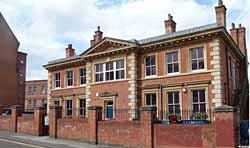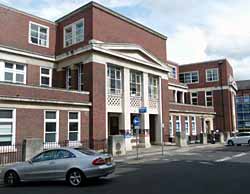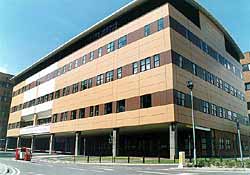
Nottingham Ear, Nose and Throat Services
This section has been written by Prof Patrick J. Bradley.
When considering the provision of medical facilities, such as Ear, Nose and Throat services (ENT), it is necessary to consider the history of medicine, its development and traditions, as well as surgery in general, and more so particularly important when considering what’s called the minor-specialties, ENT and Ophthalmology (eye). Looking back in time, treatment options for the common “sore throat” were to do nothing or offer and proceed to surgery, removing the tonsils. Nowadays the indications and treatment options are different, social housing and healthcare are very different. Penicillin, an antibiotic, considered now-a-days to be a cure for most “infections”, only became available in Nottingham Hospitals in 1945 and then only for a named patient with very restricted diseases! Chronic discharging ears, once very common, associated with a fatal outcome if not treated properly, is now much less common, but remains a potentially serious disease, and to avoid complications a correct diagnosis must be made early and managed correctly! Surgery is not always necessary.
Dr Donald Stewart, as a medical student spent holiday time in general practice in Nottingham and after a period as a resident house surgeon in Ear, Nose and Throat Department at Blackburn (1874) returned to Nottingham (1876) as a partner in general practice. One of his medical school classmates, Dr Walter Hunter, was the Medical Officer of Health in West Bridgford. Dr Stewart had opened a practice on Peachey Street (now Mansfield Road) in December 1866 and in 1887 he sought support for the establishment of a “Hospital for Diseases of the Throat and Ear for the necessitous poor, free of all charges”. At this time the nearest specialist throat and ear hospital was at The Birmingham Ear Infirmary (established 1844). In the East Midlands such specialist ENT service were established at a much later date: Leicester Royal Infirmary (1890), Sheffield Royal Hospital (1897), Derby Royal Infirmary (1905), and Lincoln (1913), all being located in large General Hospitals.
Dr. Stewart's specialist practice was registered as The Nottingham and Nottinghamshire Hospital for Diseases of the Throat, Ear and Nose which provided an out-patient service only, until 1905 when six beds became available. Stewart worked alone initially and reported at the First Annual General Meeting 1888, that during the 13 months he had seen 515 new patients, increasing to 773 by 1891. The early clinic opened only one day a week, gradually increasing to two and then three clinics a week. Stewart resigned in 1896 because of ill-health, and died in Aylesbury in 1914. Additional and replacement staff was recruited over time – best considered part-time general practitioners who had some specialisation. By 1924 a domestic house was purchased on Goldsmith Street, required extensive refurbishment and building opened in 1928 becoming what could be termed a “modern hospital” with out- and in-patient services. By 1935 almost all of the medical staff was provided by surgeons who worked at the General Hospital, Nottingham (GHN). The patient clinical activity during the subsequent years, not consistently reported but peak numbers showed that in 1929, 2,095 new patients were seen. In 1930, 774 operations were performed and in 1935 8,420 patients had attended. The Stewart’s Hospital had a constant and recurring problem with finance, but seemingly by coincidence in 1940, The Saturday Fund1 contributed funds and in the first year the contribution of almost 50% of its annual budget. A National Survey of Hospitals in England reported that the Stewart’s Hospital “was grossly overcrowded … housed in buildings unsuitable for hospital work” in 1945. This resulted in closure of the Hospital and amalgamation with the ENT Department at GHN in 1947.
Children were particularly prone to suffer from ear and throat infections and from the 1940’s until the 1970’s it was not uncommon for children to have their tonsils and adenoids removed for recurrent “sore throat and recurrent ear infections”. Such surgery was so common that the indication for such interventions was questioned (about 2,500 a year in the 1940’s), and while the numbers have reduced the practice continues to be questioned by modern-day doctors and surgeons.

The School Clinic Building in Chaucer Street opened in 1928.
In 1907 the Education Act instructed Local Authorities to set up medical inspection units for school going children. Over their schooling years, each child would be given a medical examination on no less than three occasions. The initial examination facility provided, was cramped and deemed unsuitable and in 1926 a refurbished building was opened on Chaucer Street. The Central School Health Clinic had built an operating theatre and bed facilities used by Ear, Nose & Throat and Dental Surgery. Between 1918 and 1926 the children listed for tonsils and adenoids had their surgery at the Children’s Hospital performed by Mr. Bell Tawse. When the Chaucer Street Clinic opened in 1926, surgery was performed in-house until 1965 by surgeons based at GHN, and the clinic closed in 1976.

Ropewalk House, opened in 1927, houses Hearing Services and the Nottingham Cochlear Implant Programme.
The Children’s Hospital moved from near the GHN to Forest House (the former home of Thomas Birkin) and was formally opened in 1900. Shortly after opening, two ear, nose and throat Honorary Assistant Surgeons were appointed, Mr. Tweedie (1908) and Mr. Bell Tawse (1909). Both had trained in London and were Fellows of the Royal College of Surgeons. Interestingly, the GHN also appointed both as Honorary Assistant Surgeons, Tweedie (1911) and Bell Tawse (1914) to be Honorary Assistant Aural Surgeons. By 1920 it was recognised that the service provided by Tweedy and Bell Tawse deserved recognition with both appointed as Honorary Surgeons and the creation and founding of a separate Ear, Nose and Throat Department. The Ropewalk Wing, extension of the GHN was opened in 1927, which was recognition that the cramped space that ear, nose and throat (ENT) had worked in for years, needed to be improved. The new build has allocated space on the first floor exclusively for the ENT Department which included out- and in-patient services, wards, and theatre for both children and adults. Records of their specialist activity not previously separated from surgery in general, but by 1926 it was recorded that the GHN ENT Department saw 1,865 new patients, performed surgery on 430, with outpatient activity of 10,196 attendances. By the 1940’s more than 3,000 new patients were being seen annually.
The Children’s Hospital closed in 1978 and all activity was transferred to the University Hospital, Queen’s Medical Centre. The work of the Department of Ear, Nose and Throat, was also moved with outpatients at the Ropewalk House (changed from Wing) to University Hospital in 1978, leaving the ward and theatres, which moved in 1983. So, by 1983 all four hospitals/clinics conducting out- and in-patient service had been amalgamated and centralised onto one site.

The current Eye, Ear, Nose and Throat
Department at the Queens Medical Centre site (opened 2000).
Before the building of the Queens Medical Centre, Nottingham’s hospitals and hospital services were scattered across the city. In 2000 a purpose-built department was opened within the Queens Medical Centre Campus which accommodated out- and in-patient facilities for ophthalmology and ear, nose and throat services. The Hearing Services, the Children’s Hearing Assessment Centre and the Nottingham Paediatric Cochlear Implant Services took over the vacated space and facilities at Ropewalk House, where they remain today.
1. This fund provided most of the money for the Nottingham General Hospital. In the 1930s the fund moved from a subscriber-based system of recommendations to a contributory scheme based on vouchers.